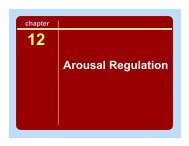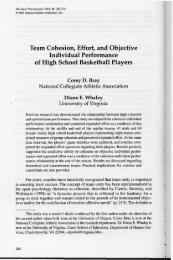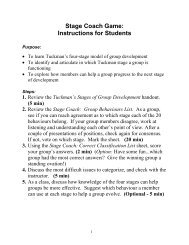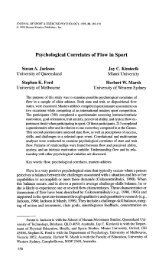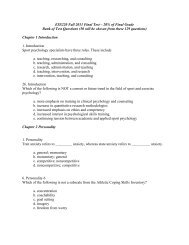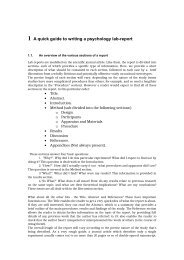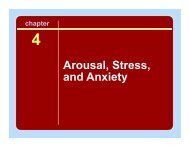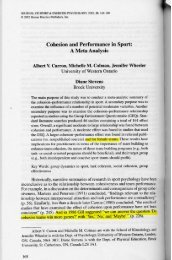Sport and Exercise Psychology Review - Sport Psychology Goes to ...
Sport and Exercise Psychology Review - Sport Psychology Goes to ...
Sport and Exercise Psychology Review - Sport Psychology Goes to ...
You also want an ePaper? Increase the reach of your titles
YUMPU automatically turns print PDFs into web optimized ePapers that Google loves.
Context <strong>and</strong> Physical Activity<br />
an exercise setting; <strong>and</strong> completely alone.<br />
Similarly, when participants were asked <strong>to</strong><br />
select their least preferred context, these<br />
same four response options were offered.<br />
As the results in Table 1 show, for females,<br />
exercising with others outside of a structured<br />
class setting was identified as their most preferred<br />
context (29.5 per cent), followed<br />
closely by exercising completely alone (28.8<br />
per cent) <strong>and</strong> in a structured class (26.6 per<br />
cent). Interestingly, female adults also identified<br />
exercising in a structured class as their<br />
least preferred context (51.8 per cent). For<br />
males, two contexts were identified as most<br />
preferred – exercising with others outside of<br />
a structured class setting (38.8 per cent) <strong>and</strong><br />
exercising completely alone (38.8 per cent).<br />
Male adults also identified exercising in a<br />
structured class as their least preferred context<br />
for aerobic activity (65.0 per cent).<br />
University students<br />
Burke, Carron <strong>and</strong> Eys (in press) conducted<br />
a similar study using a sample (n = 601) of<br />
undergraduate students (19–25 years). That<br />
is, participants were asked <strong>to</strong> identify their<br />
most <strong>and</strong> least preferred contexts for aerobic<br />
activity from the same four response options<br />
listed above. As the results in Table 2 show,<br />
for females, exercising with others outside of<br />
a structured class setting was the most preferred<br />
context (39.8 per cent), <strong>and</strong> exercising<br />
completely alone was the least preferred<br />
(43.5 per cent). For males, exercising with<br />
Table 1: Contexts most <strong>and</strong> least preferred by adults for engaging in aerobic physical activity<br />
(adapted from Burke et al., 2005)<br />
Percent of Percent of Percent of Percent of<br />
females indicating females indicating males indicating males indicating<br />
Context MOST preferred LEAST preferred MOST preferred LEAST preferred<br />
Structured class 26.6 51.8 6.3 65.0<br />
With others outside 29.5 10.8 38.8 6.3<br />
of a structured class<br />
On your own in an 15.1 10.8 16.3 6.3<br />
exercise setting<br />
Completely alone 28.8 26.6 38.8 22.5<br />
Table 2: Contexts most <strong>and</strong> least preferred by university students for engaging in aerobic physical<br />
activity (adapted from Burke et al., in press)<br />
Percent of Percent of Percent of Percent of<br />
females indicating females indicating males indicating males indicating<br />
Context MOST preferred LEAST preferred MOST preferred LEAST preferred<br />
Structured class 26.1 27.9 3.0 78.7<br />
With others outside 39.8 13.3 54.8 1.6<br />
of a structured class<br />
On your own in an 24.6 15.3 21.8 4.8<br />
exercise setting<br />
Completely alone 9.5 43.5 20.4 14.9<br />
<strong>Sport</strong> & <strong>Exercise</strong> <strong>Psychology</strong> <strong>Review</strong> Vol 1 No 2 25



